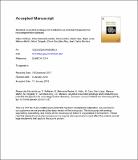Por favor, use este identificador para citar o enlazar a este item:
http://hdl.handle.net/10261/163397COMPARTIR / EXPORTAR:
 SHARE SHARE
 CORE
BASE CORE
BASE
|
|
| Visualizar otros formatos: MARC | Dublin Core | RDF | ORE | MODS | METS | DIDL | DATACITE | |

| Título: | Alkylated resveratrol prodrugs and metabolites as potential therapeutics for neurodegenerative diseases |
Autor: | Peñalver, Pablo CSIC ORCID; Belmonte-Reche, Efres; Adán, Norma; Caro, Marta; Mateos-Martín, María Luisa CSIC ORCID; Delgado, M.; González-Rey, Elena CSIC ORCID; Morales, Juan C. | Palabras clave: | Inflammation Neurodegenerative diseases Neuroprotection Prodrug Resveratrol Zebra fish |
Fecha de publicación: | 25-feb-2018 | Editor: | Elsevier | Citación: | European Journal of Medicinal Chemistry | Resumen: | Resveratrol is a naturally occurring stilbene which has shown promising results as treatment for several neurodegenerative diseases. However, its application is limited due to its low efficacy and bioavailability. Here, we have designed and synthesized alkylated resveratrol prodrugs combining structural modification to improve antioxidant and anti-inflammatory properties and the preparation of prodrugs to extend drug bioavailability. For comparison we also studied resveratrol prodrugs and alkylated resveratrol derivatives. Methylated and butylated resveratrol derivatives showed the best in vitro neuroprotective and anti-inflammatory activity. The glucosyl- and glucosyl-acyl- prodrugs of these derivatives showed lower toxicity on zebra fish embryo. When neuroprotection was examined on pentylenetetrazole challenged zebra fish, they were capable of reverting neuronal damage but to a lower extent than resveratrol. Nevertheless, 3-O-(6'-O-octanoyl)-β-d-glucopyranoside resveratrol (compound 8) recovered AChE activity over 100% whereas resveratrol only up to 92%. In a 3-nitropropionic acid mice model of Huntington's disease, resveratrol derivative 8 delayed the onset and reduced the severity of HD-like symptoms, by improving locomotor activity and protecting against weight loss. Its effects involved an equal antioxidant but better anti-inflammatory profile than resveratrol as shown by SOD2 expression in brain tissue and circulating levels of IL-6 (11 vs 18 pg/mL), respectively. Finally, the octanoyl chain in compound 8 could be playing a role in inflammation and neuronal development indicating it could be acting as a double-drug, instead of as a prodrug | URI: | http://hdl.handle.net/10261/163397 | DOI: | 10.1016/j.ejmech.2018.01.037 | ISSN: | 0223-5234 | E-ISSN: | 1768-3254 |
| Aparece en las colecciones: | (IPBLN) Artículos |
Ficheros en este ítem:
| Fichero | Descripción | Tamaño | Formato | |
|---|---|---|---|---|
| EJMC2018_Peñalver et al_just accepted.pdf | 1,37 MB | Adobe PDF |  Visualizar/Abrir |
CORE Recommender
SCOPUSTM
Citations
55
checked on 20-abr-2024
WEB OF SCIENCETM
Citations
52
checked on 21-feb-2024
Page view(s)
410
checked on 23-abr-2024
Download(s)
447
checked on 23-abr-2024
Google ScholarTM
Check
Altmetric
Altmetric
NOTA: Los ítems de Digital.CSIC están protegidos por copyright, con todos los derechos reservados, a menos que se indique lo contrario.
